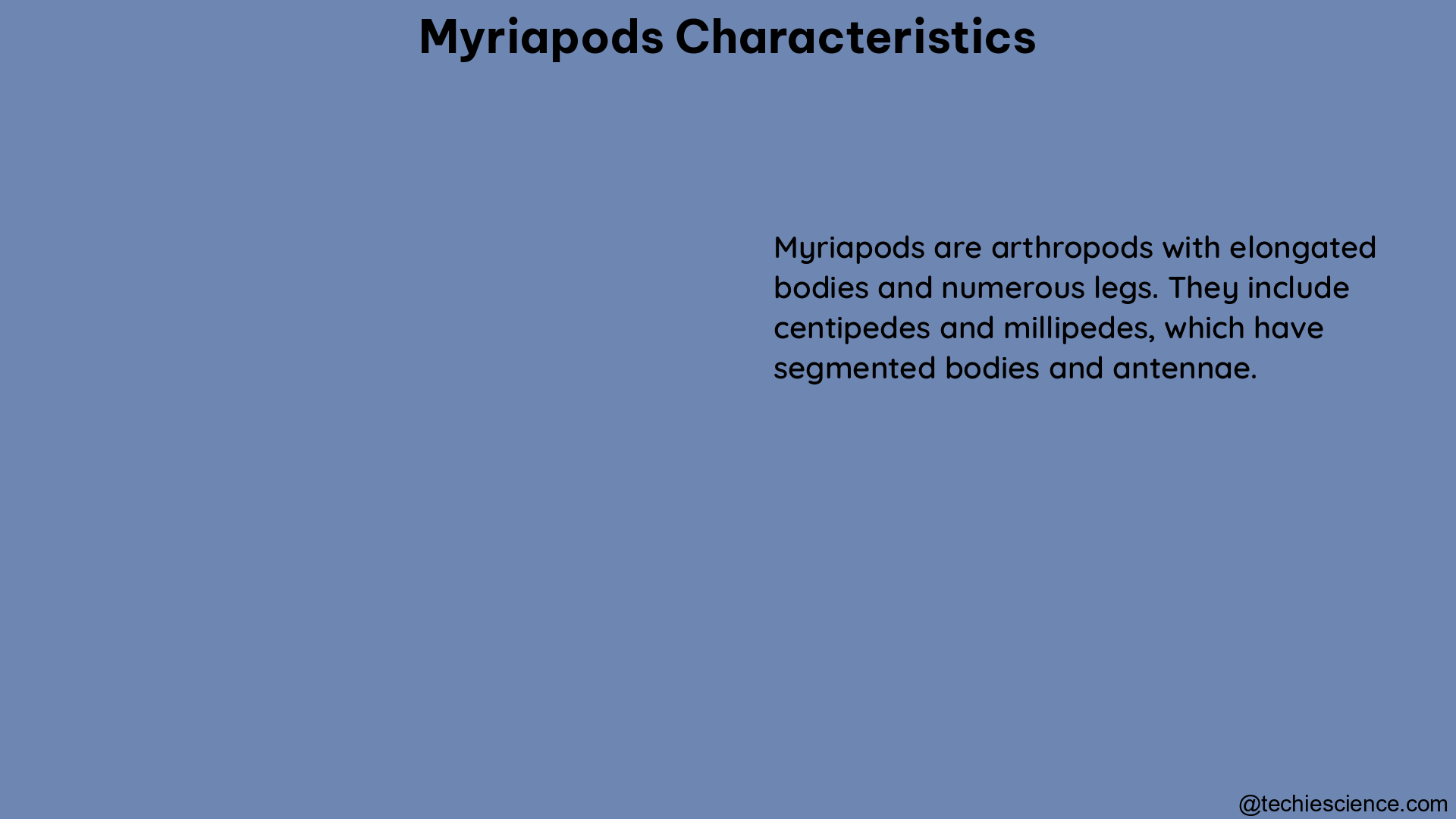Myriapods, a diverse group of terrestrial arthropods, are renowned for their unique biological features and adaptations. From their intricate anatomy to their ecological roles, these fascinating creatures offer a wealth of information for biologists and nature enthusiasts alike. In this comprehensive guide, we will delve into the measurable and quantifiable characteristics that define the world of myriapods.
Taxonomic Diversity: Unraveling the Myriapod Classes
Myriapods are divided into four distinct classes, each with its own set of distinguishing features:
-
Chilopoda (Centipedes): With approximately 3,000 known species, centipedes are the largest and most diverse class of myriapods. They are characterized by their elongated, flattened bodies and a single pair of legs per body segment.
-
Diplopoda (Millipedes): Millipedes, with around 12,000 species, are the most numerous myriapods. They have cylindrical bodies and two pairs of legs per body segment, giving them a distinctive appearance.
-
Pauropoda: This class comprises approximately 800 species and is known for their small size, typically ranging from 0.5 to 2 millimeters in length. Pauropods have unique, branched antennae and a reduced number of body segments compared to other myriapod classes.
-
Symphyla: With around 200 species, Symphylans are the smallest myriapods, often measuring less than 5 millimeters in length. They have a distinct, elongated body shape and a single pair of legs per body segment.
Genome Size Diversity: Exploring the Genetic Landscape

The genome size of myriapods varies significantly across species, reflecting the evolutionary adaptations and genetic complexity within this group. Some key data points:
- The centipede Strigamia maritima has a genome size of 2.2 Gb (gigabases), making it one of the smallest myriapod genomes known.
- In contrast, the millipede Glomeris marginata has a genome size of 6.2 Gb, nearly three times larger than that of Strigamia maritima.
- This vast range in genome size highlights the diverse genetic makeup and evolutionary trajectories of different myriapod species.
Leg Count Diversity: Debunking the Myths
Myriapods are often associated with their impressive leg counts, but the common names “centipede” and “millipede” can be misleading. Let’s explore the true leg counts of these fascinating creatures:
- Centipedes can have anywhere from 30 to 354 legs, with the majority of species having between 30 and 50 legs.
- Millipedes, on the other hand, can have between 22 and 750 legs, with most species having around 40 to 400 legs.
- The “centipede” name, which means “100 feet” in Latin, is a misnomer, as no species has exactly 100 legs. Similarly, the “millipede” name, meaning “1,000 feet” in Latin, is also a misnomer, as no species has as many as 1,000 legs.
Segmentation Diversity: Unraveling the Multisegmented Trunk
Myriapods are characterized by their multisegmented trunk, which is supported by a large number of legs. The number of body segments can vary significantly between species:
- Some myriapod species, such as the centipede Scolopocryptops sexspinosus, can have as many as 191 body segments.
- In contrast, other species, like the millipede Polyxenus lagurus, have a relatively low number of body segments, around 11 to 13.
- This diversity in segmentation reflects the evolutionary adaptations and ecological niches occupied by different myriapod species.
Geographical Distribution: Exploring the Global Reach
Myriapods are found worldwide, with the majority of species occurring in tropical and subtropical regions. However, their distribution patterns vary:
- Some myriapod species, such as the centipede Scolopendra cingulata, have a wide geographical range, spanning multiple continents.
- Other species, like the millipede Glomeris marginata, are endemic to specific regions, such as parts of Europe.
- This variation in distribution highlights the adaptability and specialization of myriapods to different environmental conditions and habitats.
Ecological Roles: Myriapods as Keystone Species
Myriapods play crucial roles in terrestrial ecosystems, serving as both predators and decomposers:
- Centipedes as Predators:
- Centipedes are active predators that help control insect populations and other small invertebrates.
-
They use their venomous fangs to subdue and consume their prey, playing a vital role in maintaining the balance of terrestrial food webs.
-
Millipedes as Decomposers:
- Millipedes are important decomposers, breaking down plant material and contributing to nutrient cycling in the soil.
-
Their feeding activities help to aerate the soil and improve its fertility, making them valuable indicators of soil health.
-
Pauropods and Symphylans:
- Pauropods and Symphylans, though smaller in size, also contribute to the decomposition of organic matter and the maintenance of soil structure.
- Their presence in the soil can provide insights into the overall health and functioning of the ecosystem.
Habitat Requirements: Myriapods as Indicator Species
Myriapods are highly dependent on specific environmental conditions, making them valuable indicator species for assessing soil and habitat quality:
- Moisture: Myriapods require a certain level of moisture in their environment to survive and thrive. Changes in soil moisture can directly impact their population dynamics.
- Temperature: Different myriapod species have adapted to varying temperature ranges, with some preferring cooler, moist habitats and others thriving in warmer, drier conditions.
- Soil Composition: The composition and structure of the soil, including pH, organic matter content, and nutrient levels, can significantly influence the presence and abundance of myriapod species.
By monitoring the diversity and abundance of myriapod communities, researchers can gain insights into the overall health and condition of the ecosystem, making them valuable tools for environmental assessment and conservation efforts.
Developmental Biology: Metamorphosis and Molting
Myriapods undergo a complex developmental process that involves multiple stages and morphological changes. This process is known as metamorphosis and includes the following key aspects:
- Embryonic Development:
- Myriapod embryos develop within the egg, undergoing a series of cell divisions and tissue differentiation.
-
The number of body segments and other morphological features are established during this early stage of development.
-
Larval Stages:
- After hatching, myriapods go through a series of larval stages, known as instars, before reaching adulthood.
- For example, the centipede Lithobius forficatus undergoes 14 developmental stages before reaching the adult form.
-
During these larval stages, the myriapod undergoes significant changes in body size, segment number, and leg count.
-
Molting and Growth:
- Myriapods, like other arthropods, must shed their exoskeleton (molt) in order to grow and develop.
- This process involves the formation of a new, larger exoskeleton beneath the old one, followed by the shedding of the old exoskeleton.
- Molting allows myriapods to increase in size and acquire new features as they progress through their developmental stages.
Understanding the complex developmental biology of myriapods provides valuable insights into their life histories, adaptations, and evolutionary trajectories.
In conclusion, the captivating world of myriapods is a testament to the remarkable diversity and adaptability of terrestrial arthropods. From their taxonomic classification and genome size variations to their leg counts, segmentation patterns, and ecological roles, these fascinating creatures offer a wealth of information for biologists and nature enthusiasts alike. By delving into the measurable and quantifiable characteristics of myriapods, we can gain a deeper appreciation for the intricate web of life that exists in our terrestrial ecosystems.
References:
– Senckenberg Museum of Natural History Görlitz: Myriapoda Research
– Genome Size Diversity and Evolution in the Myriapoda
– Myriapoda on ScienceDirect
– Myriapoda on ScienceDirect (Agricultural and Biological Sciences)
– Evolutionary Developmental Biology of Myriapods

Hello, I am Piyali Das, pursuing my Post Graduation in Zoology from Calcutta University. I am very passionate on Academic Article writing. My aim is to explain complex things in simple way through my writings for the readers.